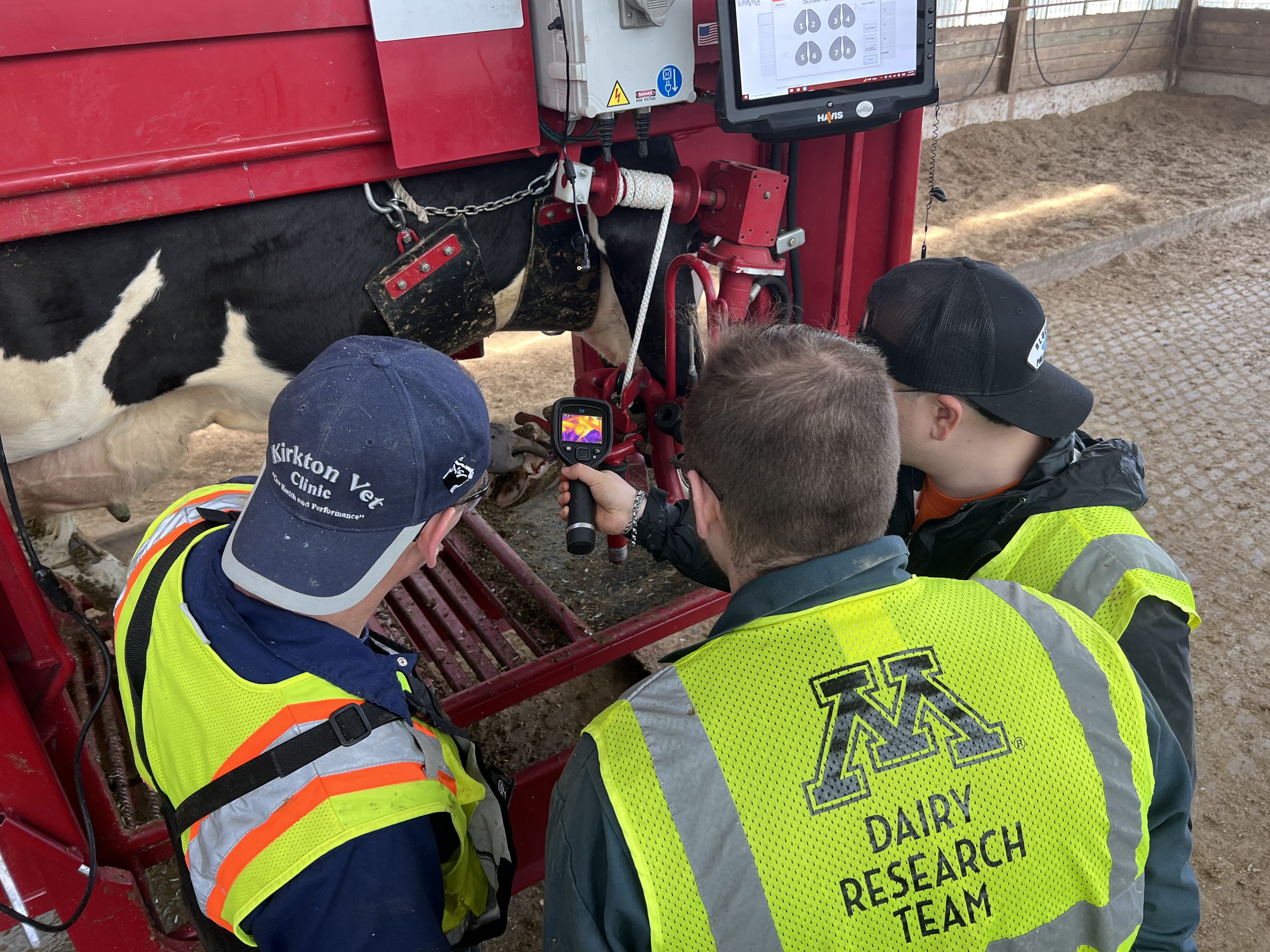AI on the prize
CVM professor Gerard Cramer sees artificial intelligence as the future for healthier cows and more productive dairy farms

CVM professor Gerard Cramer sees artificial intelligence as the future for healthier cows and more productive dairy farms
Image generated by AI technology
Dr. Gerard Cramer always wanted to be a dairy farmer. He grew up on his family’s dairy farms, first in the Netherlands, and then in Canada, but when he finished college, his father thought he was too young to take over the farm. So he set his sights on vet school as the next best thing.
Cramer received both Doctor of Veterinary Medicine and Doctor of Veterinary Science degrees from the University of Guelph, and he spent several years running his own dairy farm as well as working in private veterinary practice with a focus on cows. But he kept ruminating about a problem he’d seen on farms his whole life: lameness.
Lameness is a clinical sign of pain related to the locomotor system, causing abnormal movement or posture. In cows, it typically results from hoof lesions, but it can also be caused by such things as joint issues, traumatic injuries, or neurological diseases.

Affecting nearly one-quarter of dairy cows worldwide, lameness has a serious impact on animal welfare. Farmers, too, feel the effects because of decreased milk yield in cows with lameness, in addition to the cost of treatment.
“Lameness greatly affects animals and farms, and it's not something that’s really being worked on,” Cramer says. Seeing a need that no one was addressing, he decided to sell the farm—and shift his focus to research.
With the experience and technical skills he gained from years of farming and veterinary practice, along with the research skills he gained in graduate school, Cramer was in a unique position to understand and address the needs of farmers. He joined the faculty of the University of Minnesota College of Veterinary Medicine in 2013, and his research has focused on developing an evidence base for the prevention and treatment of lameness. He has evaluated the impact of hoof-trimming techniques, metabolic health, pharmaceutical treatments—and most recently, artificial intelligence.
A cow barn might seem like an unexpected place to find cutting-edge artificial intelligence (AI) tools in action, but Cramer and graduate student Drew Swartz, who works in Cramer’s lab, say the technology could solve some of the problems that make lameness a difficult problem to tackle.

Lameness is determined by observing a cow and scoring it based on the characteristics of its gait. If this “locomotion score” is above a certain level, the cow is considered lame. The challenges of identifying lameness are twofold.
First, the scoring process is somewhat subjective. Individual observers must quickly identify movement patterns for each cow, based on a set of standards that themselves involve natural variation, and that can be impacted by the surface the cow is walking on along with other circumstantial factors. In addition, observers have to be able to identify the lame cow by the number on her ear tag, which could be missing, dirty, or otherwise difficult to see.
Second, the scoring process is resource intensive. Observing and scoring every cow on a farm requires significant labor power, and for many farms, a once-per-week scoring frequency is a stretch. That can be a problem because the longer lameness goes undetected, the more likely it is to cause problems later on. “Cows are stoic animals, so they don’t show their pain readily,” Cramer described. “We have to be very intentional about looking for it.”
Cramer and Swartz are evaluating an AI technology that could mitigate both problems.
The technology, created by the company CattleEye, uses a camera and a machine-learning algorithm to generate locomotion scores. “At a basic level, you have a camera taking a video of the cow,” Swartz described. “The AI technology ‘watches’ the video and uses key features of the cow’s movement to try to match it to preexisting, accurately human-scored videos. It uses this matching process to generate the score, which it sends back to the farm.”
In the first instance, the technology can provide more consistency than a human eye in generating locomotion scores. And in the second instance, it can generate a greater volume of data than any one farm can analyze using people power—enabling more frequent scoring and freeing up the human labor force for more complex tasks.
For Cramer and Swartz, the real question is what comes next. Identifying lameness is only the first step: farmers then need to understand what’s causing the lameness, and if and how it can be treated. Since hoof lesions are the most common cause of lameness—and are treatable—the researchers want to know if the AI technology can go a step further to help them specifically identify cows with lesions.
In a recent study published in the Journal of Dairy Science, they explored what other factors need to be considered in order to detect lesions. They discovered that incorporating data on hoof trimming, milk production, and cow demographics shows promise. Swartz is now working on developing an algorithm that, when combined with the original scoring algorithm, could help farmers to quickly and efficiently identify cows with treatable lesions.

“We’re thinking about it from an applied perspective, not a theoretical one,” notes Swartz, who is pursuing his PhD in veterinary medicine under Cramer’s direction.
Cramer anticipates an exciting future for the technology: “This is just the beginning—and with the lessons we’ve learned, hopefully, we can improve on these processes going forward.” He notes that there are other groups using AI to work toward the same goal of detecting and reducing lameness but from different angles. Some, for example, are exploring how to use the technology to inform breeding decisions by determining bulls' genetic disposition for lameness.
“Our approach is unique because we’re focused on how the individual farms can actually use this technology on the ground,” Cramer says. “We’re not there yet, but if we can get to a point where the technology allows a farmer to find the lesions early—to say ‘Here’s a lame cow, and I can treat this cow’—that would be really valuable to that farmer.”
Ultimately, Cramer sees himself as an advocate for cows: “They’re amazing animals. I see my job as trying to make sure we're taking care of them to the best of our ability, and doing our best by them.”
With new AI tools in hand, our best could get better.
More than data:
The growing role of artificial intelligence in research at CVM
AI brings 30 years of data to the real world
Veterinarians have struggled to control an elusive and deadly swine virus for decades. Can AI change that?
Prediction and prevention:
Research leverages AI to identify dogs at higher risk for cancer